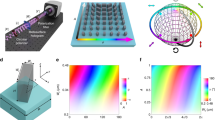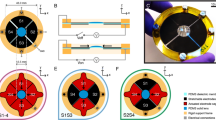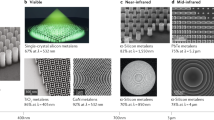Abstract
Birefringence, from the very essence of the word itself, refers to the splitting of light rays into two parts. In natural birefringent materials, this splitting is a beautiful phenomenon, resulting in the perception of a double image. In optical metamaterials, birefringence is often an unwanted side effect of forcing a device designed through transformation optics1,2,3,4,5,6 to operate in dielectrics. One polarization is usually implemented in dielectrics, and the other is sacrificed7,8. Here we show, with techniques beyond transformation optics, that this need not be the case, that both polarizations can be controlled to perform useful tasks in dielectrics, and that rays, at all incident angles, can even follow different trajectories through a device and emerge together as if the birefringence did not exist at all. A number of examples are shown, including a combination Maxwell fisheye/Luneburg lens that performs a useful task and is achievable with current fabrication materials.
This is a preview of subscription content, access via your institution
Access options
Subscribe to this journal
Receive 12 print issues and online access
$209.00 per year
only $17.42 per issue
Buy this article
- Purchase on Springer Link
- Instant access to full article PDF
Prices may be subject to local taxes which are calculated during checkout

Similar content being viewed by others
References
Service, R. F. & Cho, A. Strange new tricks with light. Science 330, 1622 (2010).
Leonhardt, U. Optical conformal mapping. Science 312, 1777–1780 (2006).
Pendry, J. B., Schurig, D. & Smith, D. R. Controlling electromagnetic fields. Science 312, 1780–1782 (2006).
Shalaev, V. M. Transforming light. Science 322, 384–386 (2008).
Chen, H. Y., Chan, C. T. & Sheng, P. Transformation optics and metamaterials. Nature Mater. 9, 387–396 (2010).
Leonhardt, U. & Philbin, T. G. Geometry and Light: The Science of Invisibility (Dover, 2010).
Schurig, D. et al. Metamaterial electromagnetic cloak at microwave frequencies. Science 314, 977–980 (2006).
Ma, Y. G., Ong, C. K., Tyc, T. & Leonhardt, U. An omnidirectional retroreflector based on the transmutation of dielectric singularities. Nature Mater. 8, 639–642 (2009).
Pendry, J. B. Negative refraction makes a perfect lens. Phys. Rev. Lett. 85, 3966–3969 (2000).
Cai, W. S., Chettiar, U. K., Kildishev, A. V. & Shalaev, V. M. Optical cloaking with metamaterials. Nature Photon. 1, 224–227 (2007).
Gabrielli, L. H., Cardenas, J., Poitras, C. B. & Lipson, M. Silicon nanostructure cloak operating at optical frequencies. Nature Photon. 3, 461–463 (2009).
Leonhardt, U. & Tyc, T. Broadband invisibility by non-Euclidean cloaking. Science 323, 110–112 (2009).
Liu, R. et al. Broadband ground-plane cloak. Science 323, 366–369 (2009).
Valentine, J., Li, J. S., Zentgraf, T., Bartal, G. & Zhang, X. An optical cloak made of dielectrics. Nature Mater. 8, 568–571 (2009).
Ergin, T., Stenger, N., Brenner, P., Pendry, J. B. & Wegener, M. Three-dimensional invisibility cloak at optical wavelengths. Science 328, 337–339 (2010).
Landy, N. I., Sajuyigbe, S., Mock, J. J., Smith, D. R. & Padilla, W. J. Perfect metamaterial absorber. Phys. Rev. Lett. 100, 207402 (2008).
Luneburg, R. K. & Herzberger, M. Mathematical Theory of Optics (Brown University Graduate School, 1944).
Gutman, A. S. Modified Luneberg lens. J. Appl. Phys. 25, 855–859 (1954).
Morgan, S. P. General solution of the Luneberg lens problem. J. Appl. Phys. 29, 1358–1368 (1958).
Kwon, D. H. & Werner, D. H. Polarization splitter and polarization rotator designs based on transformation optics. Opt. Express 16, 18731–18738 (2008).
Hendi, A., Henn, J. & Leonhardt, U. Ambiguities in the scattering tomography for central potentials. Phys. Rev. Lett. 97, 073902 (2006).
Akbarzadeh, A. & Danner, A. J. Generalization of ray tracing in a linear inhomogeneous anisotropic medium: a coordinate-free approach. J. Opt. Soc. Am. A 27, 2558–2562 (2010).
Danner, A. J. Visualizing invisibility: metamaterials-based optical devices in natural environments. Opt. Express 18, 3332–3337 (2010).
Minano, J. C. Perfect imaging in a homogeneous three-dimensional region. Opt. Express 14, 9627–9635 (2006).
Leonhardt, U. Perfect imaging without negative refraction. New J. Phys. 11, 093040 (2009).
Ma, Y. G., Sahebdivan, S., Ong, C. K., Tyc, T. & Leonhardt, U. Evidence for subwavelength imaging with positive refraction. New J. Phys. 13, 033016 (2011).
Acknowledgements
The authors acknowledge funding from the Singapore Ministy of Education Tier II Academic Research Fund (grant no. MOE2009-T2-1-086). U.L. was supported by the Royal Society. T.T. acknowledges grants nos MSM0021622409 and MSM0021622419 from the Czech Ministry of Education.
Author information
Authors and Affiliations
Contributions
A.D. devised the main theory presented in the text and created ray-traced images. T.T. contributed to designing the interior focusing and multifocal length lenses. U.L. proposed the original problem and contributed to potential applications of the theory.
Corresponding author
Ethics declarations
Competing interests
The authors declare no competing financial interests.
Supplementary information
Rights and permissions
About this article
Cite this article
Danner, A., Tyc, T. & Leonhardt, U. Controlling birefringence in dielectrics. Nature Photon 5, 357–359 (2011). https://doi.org/10.1038/nphoton.2011.53
Received:
Accepted:
Published:
Issue Date:
DOI: https://doi.org/10.1038/nphoton.2011.53
This article is cited by
-
A conformal mapping approach to broadband nonlinear optics on chip
Nature Photonics (2024)
-
Effects of dual cross Kerr non-linearity on the manipulation of rotary photon drag
Optical and Quantum Electronics (2023)
-
Phase control of pulses distortions through induced circular birefringent chiral atomic medium
Optical and Quantum Electronics (2022)
-
Hanbury Brown and Twiss measurements in curved space
Nature Photonics (2016)
-
Directionally hiding objects and creating illusions above a carpet-like device by reflection holography
Scientific Reports (2015)



